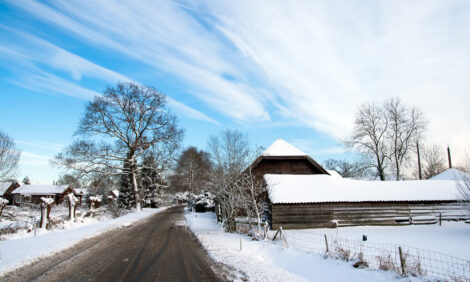



New center will provide technologies to enhance competitiveness of small and medium Brazilian farmers
New center will boost internet coverage and directly connecting producers and buyersDirectly connecting producers and buyers without middlemen, tracking production, connecting machines in networks – these are just a few of the solutions made possible by the mobile internet and other digital technologies to help farmers cut costs, increase their competitiveness and make their activities more sustainable.
However, they may well be beyond the reach of small and medium farmers in Brazil, where only 23% of rural areas have internet coverage. Boosting this proportion is one of the main aims of the new Science for Development Center in Digital Agriculture (SDC-DA/SemeAr), launched on April 11 in Campinas, São Paulo state, Brazil (semear is Portuguese for sowing seeds).
The center is a collaboration between EMBRAPA Digital Agriculture – a unit of the Brazilian Agricultural Research Corporation (EMBRAPA) – and FAPESP, in partnership with several other institutions that share the goal of offering small and medium farmers solutions based on connectivity and digital technology with the support of business and government.
“FAPESP’s mission is to look to the future and provoke higher education and research institutions to pursue science-based solutions,” said Marco Antonio Zago, President of FAPESP, in his opening address to the launch event.
Zago stressed the collaborative aspect of the project. Among the many players involved, besides EMBRAPA and FAPESP, are CPQD, a private-sector entity and one of Latin America’s largest R&D centers in information and communications technology (ICT); the University of São Paulo’s Luiz de Queiroz College of Agriculture (ESALQ-USP); Agronomic Institute (IAC) and Agricultural Economics Institute (IEA), arms of São Paulo’s Agency for Agribusiness Technology (APTA); the Federal University of Lavras (UFLA); and the National Institute of Telecommunications (INATEL), a private-sector higher education and research institution.
Hosted by EMBRAPA Digital Agriculture in Campinas, SDC-DA/SemeAr is one of FAPESP’s Science for Development Centers allying research institutions, government agencies, companies and nonprofits in pursuit of solutions to social and economic problems. Investment in the project will total BRL 25 million in five years.
São Paulo State Governor Tarcísio de Freitas said his creation of the Department of Science, Technology and Innovation showed the sector’s importance to his term in office.
“If we want to reduce inequality, we must invest in initiatives like this,” he said.
He recalled participating in other recent unveilings alongside FAPESP, such as the launch of the Engineering Center for Aerial Mobility of the Future (ERC-AMF), set up in partnership with Embraer at the Aeronautical Technology Institute and the creation of Institut Pasteur de São Paulo, as well as other partnerships with French research institutions.
“Brazilian agriculture has reached the current level thanks largely to EMBRAPA. We must now take connectivity to the sector, including small farmers. This center will play an important role in food security,” he said.
Sowing technology
Silvia Massruhá, principal investigator for the new center, explained that ten agricultural technology districts will be created over the five-year period to operate as pilot digital farms in different parts of Brazil. Five will be created in São Paulo state. The first two already exist. They were created in 2021 in Caconde and São Miguel Arcanjo.
“For each one, we’ll conduct a survey of economic indicators, the main problems faced by farmers, companies they can partner with, the presence of co-ops and trade associations, and so on. This will serve as a basis for networking with all these different players so that we can develop solutions using digital technology and connectivity,” Massruhá said.
Shortly before the event, EMBRAPA announced that she was to be its first female CEO.
In 2020, 84% of Brazilian farmers used at least one digital technology to support agricultural production, mainly to facilitate communication, access information, and buy and sell goods, according to a survey conducted by EMBRAPA in partnership with SEBRAE, a nonprofit that assists small enterprises, and the National Space Research Institute (INPE), an arm of the federal government.
Moreover, 95% of the farmers interviewed said they would be interested in receiving information about and acquiring more specialized digital technology, such as solutions for farm planning and management; production forecasting; control of pests, diseases, operational failures and water stress in the crops; animal health; and certification and traceability of products. The main challenges mentioned were the high cost of investment, limited internet access and the need for training.
“This project will make a very significant contribution, and not just in São Paulo state,” said Stanley Oliveira, head of EMBRAPA Digital Agriculture.
Development
Antonio Junqueira, São Paulo State Secretary of Agriculture and Food Supply, said he was impressed by the speed of the internet at the Caconde agricultural technology district when he visited, even though the terrain is hilly. Internet access was assured by a partnership with a local provider.
“The technologies being implemented will significantly cut production costs,” he noted.
For Vahan Agopyan, São Paulo State Secretary of Science, Technology and Innovation, the new center will transfer knowledge produced by academia to benefit society. “The aim is to support and include small and medium farmers,” he said.
* With information from EMBRAPA Digital Agriculture.
This text was originally published by FAPESP Agency according to Creative Commons license CC-BY-NC-ND. Read the original here.


